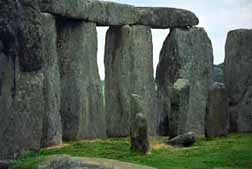Stonehenge
Stonehenge is a megalithic monument on the Salisbury Plain in Southern England, composed mainly of thirty upright stones (sarsens, each over ten feet tall and weighing 26 tons), aligned in a circle, with thirty lintels (6 tons each) perched horizontally atop the sarsens in a continuous circle. There is also an inner circle composed of similar stones, also constructed in post-and-lintel fashion.

It is thought that Stonehenge dates back thousands of years, to approximately 2800 BC.

Stonehenge is a circular setting of large standing stones surrounded by an earthwork. No one is quiet sure how old it is, who built it or what it's function was. There are many theories, ranging from an astronomical observatory (it is aligned such that it can predict eclipses etc) to religious temples to a calendar.

Stonehenge is angled such that on the equinoxes and the solstices, the sun rising over the horizon appears to be perfectly placed between gaps in the megaliths. But this is purely coincidence - the Earth's orbit has shifted several times in the 5000 years since it was built, and at the time of it's construction, the sun would not have lined up with the gaps at all!

Stonehenge sits on a major Grid Point on this planet.
Constructed without the use of draft animals and shaped by stone tools, Stonehenge was erected many miles from the quarry from which the stones came. It is an amazing feat of engineering, and many stories, both old ones and retellings, frequently name Merlin as this engineer. The building of Stonehenge is usually portrayed as a grand project commissioned by the King of Britain (be it Arthur, Aurelius or Uther). However, the archaeological evidence at Stonehenge simply does not support this.The archaeology points to a construction date between 5,000 and 3,000 years ago (more than likely, several construction dates over this time).

The monument is believed to have been an astronomical calendar used for clocking and predicting the seasons. Some researchers link it to the Crop Circle phenomenon and visitors from other worlds.

In the summer of 1996 investigator and friend, Colin Andrews, discovered a 7 inch glyph in the inner ring of a stone about four feet from the ground. The pattern matches one of the Crop Circles.
Stonehenge has a long history of building and remodeling, but excavation has revealed that there were 3 main periods of building. The first beginning, about 3100 BC, was late in the Neolithic age and included the digging of a circular ditch and ring of 56 pits called the Aubrey Holes.
In the second period, about 1,000 years later, the massive rock pillars were somehow transported from Southernwestern Wales, and put up in two distinct concentric rings around the center of the site. It is believed that this double circle was never finished and was dismantled during the period of rebuilding.

A 35 ton heel stone is thought to have been placed during this second period. This provides evidence that the people of the age used astronomy because if one stands in the center of the circle during the summer soltice, the sun can be seen to rise directly above this heel stone.
Scientists believe that Stonehenge, which was used continuously for thousands of years, allowed the people of the day to foretell eclipses of the sun and moon by where the positions of the celestial bodies were in relation to the stones.

Stonehenge has been called an astronomical observatory for marking significant events on the prehistoric calendar. Others claim that it was a sacred site for the burial of high-ranking citizens from the societies of long ago.


The Blue Stones
About 2,000 BC, the first stone circle (which is now the inner circle), comprised of small bluestones, was set up, but abandoned before completion. The stones used in that first circle are believed to be from the Prescelly Mountains, located roughly 240 miles away, at the southwestern tip of Wales. The bluestones weigh up to 4 tons each and about 80 stones were used, in all. Given the distance they had to travel, this presented quite a transportation problem. Modern theories speculate that the stones were dragged by roller and sledge from the inland mountains to the headwaters of Milford Haven. There they were loaded onto rafts, barges or boats and sailed along the south coast of Wales, then up the Rivers Avon and Frome to a point near present-day Frome in Somerset. From this point, so the theory goes, the stones were hauled overland, again, to a place near Warminster in Wiltshire, approximately 6 miles away. From there, it's back into the pool for a slow float down the River Wylye to Salisbury, then up the Salisbury Avon to West Amesbury, leaving only a short 2 mile drag from West Amesbury to the Stonehenge site.

